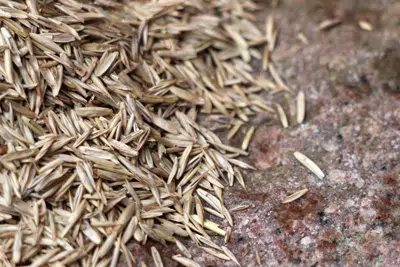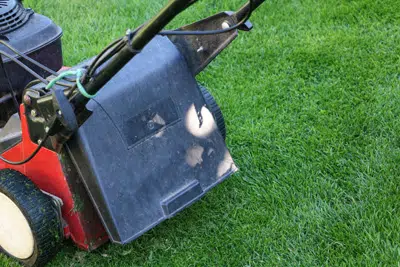Last updated on October 23rd, 2023 at 08:33 pm
For a well-groomed lawn dethatching, fertilizing and seeding are indispensable measures. Many garden owners use fertilizer and seeding before scarifying the soil. How to do it right after scarifying, read below.
Contents
Scarify lawn first – reasons
- Compaction of the soil, the lawn or due to moss
- Hard, impermeable soil due to dryness
- Presence of large areas of bare ground
- Quicker to get a well-groomed lawn
Best time
The best time for the scarifier use and subsequent seeding and fertilizing, is the spring during the month of May. The soil should be free of frost and have received time to dry. Seeds start better at the beginning of the growing season in the spring, and certain fertilizers strengthen the grass, make it more resistant and encourage dense growth.
Exception
If the lawn is heavily stressed by the winter or high load in the previous year, the scarifier should not be used first in the spring. This maintenance measure puts additional strain on lawns, so that the desired goal of a well-groomed lawn becomes a distant prospect and can even have the opposite effect. In that case, areas should be fertilized first, so that the grass can recover before the first dethatching.
Autumn
Between late August and October, the scarifier can also be used before fertilizing or seeding. Even in November, it can still be useful in combination with fertilization if heavily used lawns need to be strengthened for the cold season. Nevertheless, the spring offers the better time, because a more optimal regeneration is possible.
Note: It is important to keep in mind that the lawn in the spring has completely different requirements than in the fall and therefore the right fertilizers must be used
Work steps
- Survey and clean the lawn
- Mowing the lawn
- Cut to a grass height between three and four inches is optimal
- Do not cut on wet ground
- Ideal time to mow: early in the morning or in the evening (heat from the sun otherwise promotes drying)
- Do not mulch before scarifying
- Remove grass clippings from lawn as best as possible
- Scarify lawn
Note: For the planned fertilization after scarifying in spring, it is recommended to make a ‘general’ lawn cut first, to cause a kind of activation of the defenses. This can be done as early as April. Only the second lawn cut in May should be in preparation for the subsequent dethatching or fertilizing
Measure pH value
An important aspect for the further procedure is the currently existing pH value of the soil. If this is too low, lime should be applied before any further action, because this neutralizes and increases the pH value in the soil. Only then can the subsequently applied fertilizer develop its full effect. The lime can be spread directly after the scarifying operation. After that, it should rest lawn for four to seven days.
The “healthy” pH value looks like this:
- pH between 5.2 and 6.0 for normally permeable soils.
- pH between 6.0 and 6.5 for heavy, clayey soils
Tip: In order to obtain precise values of the soil condition and especially about the existing pH value, the purchase of a quick test is recommended, which is available in any well-stocked garden specialty store. This is a prerequisite to be able to react ideally with any corrective measures
Fertilize
Once the scarifier has done its job and the lime has survived its waiting period, fertilizer can be applied. Basically, especially the lawn stressed by the winter now needs a lot of nutrients that make the lawn grow vigorously and give it a lush green. When fertilizing, important details should be taken into account:
- Moist soil absorbs fertilizers faster and more extensively
- Choose covered day for fertilizing (ideally with rain forecast afterwards)
- Distribute fertilizer evenly and over the entire area so that growth does not take place over different periods of time
- Optimally, use fertilizer wagons for even spreading, especially on large areas
- If rain is not forthcoming, irrigate fertilized lawn area
- After fertilizing, do not walk on area for three to four days after watering/raining
- Do not leave small children and pets unattended in garden (possible risk of poisoning by eating fertilizer)
Fertilizers
- Fertilizer with nitrogen in spring (intensifies lawn greenery and promotes growth)
- Mineral slow-release fertilizer is best absorbed by weak grass roots
- In autumn, after scarifying, use fertilizers containing potassium and phosphate
Lawn seeding

Regardless of whether bare spots are to be reseeded or overall dense growth through seeding is the goal, after this lawn care described here, lawn seeding forms the final task. The following is important here:
- Waiting time between fertilization and sowing at least two weeks.
- Ideal time: between May and June – not between July and August, because of high risk of burning
- When repairing, buy seed that corresponds to the existing (for uniform overall appearance)
- When sowing in shady locations, look for appropriate characteristics when buying seed
- Sow only on level ground – smooth with roller if necessary
- Distribute seeds evenly
- Then tread down lightly
- Water carefully (soil must not get too wet, otherwise seeds will float away)
- If soil is low in humus, spread potting soil over seed (protects seed from drying out)
- Keep seeded areas continuously moist, but not too wet (never water in the sun, as young plants are very sensitive and would burn)
- Do not walk on lawn until new grass has reached about five inches in height (three to six weeks, depending on weather)
Aftercare

Lawn cuttings
As soon as the newly sown lawn has reached a height of between ten and twelve centimeters, the first lawn cut can take place. This is more a case of “top cutting”, because the young blades of grass must not be cut too short, as they are still sensitive. Ideally, the lawn mower should be set to a cutting height of eight to ten centimeters. After three to four “top cuts”, the young grass is usually so strengthened that it can be cut again to the desired/accustomed lawn length. Fertilizing again should be done at the earliest
Renewed fertilizing
Meadows should not be fertilized again after reseeding until the following year. It should be done twice a year in spring and fall. Exceptions exist if an existing damage pattern indicates a nutrient deficiency. Typical signs are:
- Poor growth and pale green – nitrogen is lacking.
- Lots of weeds growing – pH too high – administer pH minus
- Moss growth – soil too acidic – lime required
- Dense lawn matting – lawn needs nitrogen fertilization
- Bare patches mostly with brown coloring of the grass due to fungal growth – potash fertilizer can provide relief


